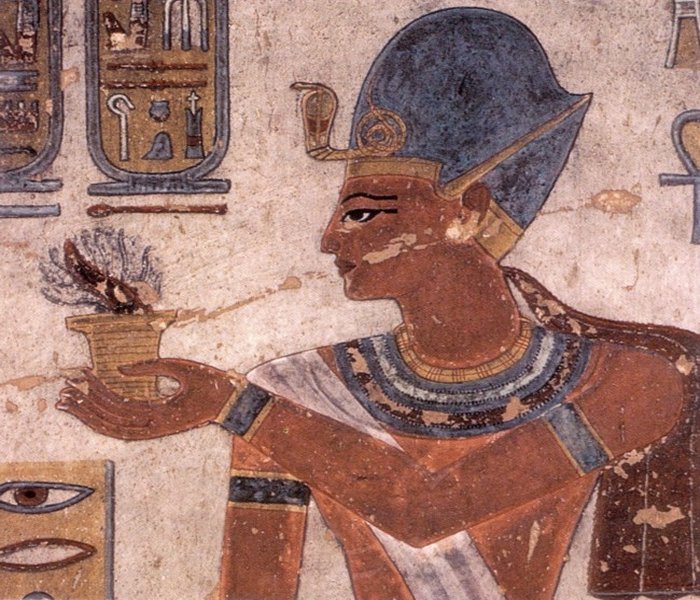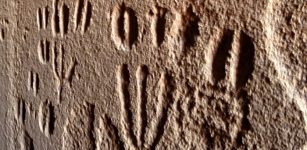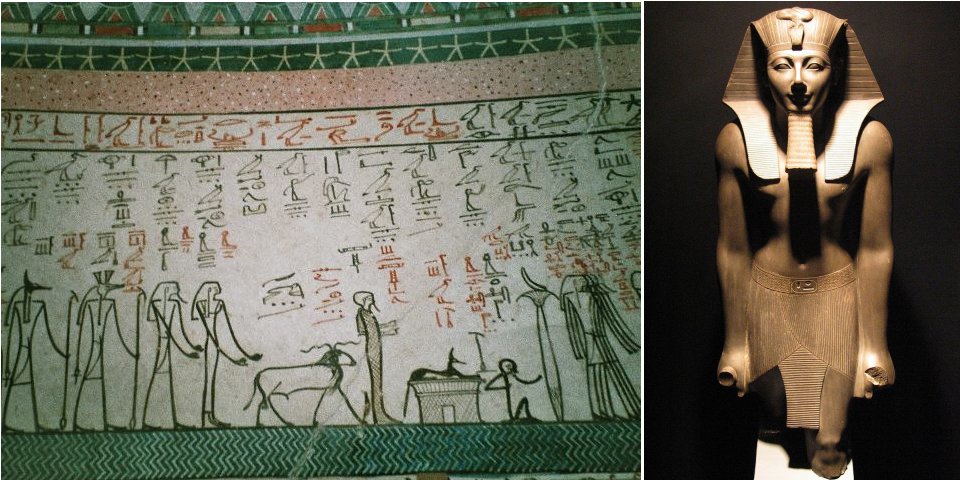Valley Of The Kings – Necropolis Of New Kingdom Rulers Of Ancient Egypt
A. Sutherland - AncientPages.com - According to an ancient Egyptian legend, the Valley of the Kings was protected by a goddess called Meretseger.
The goddess took the form of a cobra to kill anyone with evil intentions or swore false oaths.
Then, several other tombs - hidden in rocky caves - were built and the valley became a royal necropolis for the greatest personalities of ancient Egypt, such as Tutankhamun, Seti I, and Ramses II, and many others. Image via Egypt Tourism
For over 1700 years, the Egyptians buried their dead kings in pyramids and tombs.
Valley of the Kings (in Arabic: Wadi Biban el-Muluk meaning 'the Kings' Gates'), located on the Nile's west bank near Luxor, was used for burials from approximately 1539 BC to 1075 BC.
The first royal tombs in the Valley were those of Amenhotep I (still disputed) and Thutmose I, the third pharaoh of the 18th dynasty of Egypt. He received the throne after the previous king's death, Amenhotep I.
Then, several other tombs - hidden in rocky caves - were built. The Valley became a royal necropolis for the most outstanding personalities of ancient Egypt, such as Tutankhamun, Seti I, Ramses II, and many others.
Left: A scene from the Amduat on the walls of the tomb of Thutmose III, KV34, in the Valley of the Kings. Right: Thutmosis III statue in Luxor Museum. Image credit: Chipdawes - Public Domain
Many of the Valley's burial chambers were richly decorated with paintings and murals depicting the deceased's life, the scenes of the afterlife according to the Book of the Dead, and items that would enable a continued existence in the afterlife in well-being. There were also magical ritual artifacts such as Shabtis and religious figurines.
When archaeologists began excavations at the beginning of the nineteenth century, many tombs were already looted.
The first great archaeological discovery in the Valley of the Kings was made in 1768 by English traveler James Bruce. He discovered the tomb of Ramesses III, the second Pharaoh of the Twentieth Dynasty.
 Ramses III offering incense, and wall painting in KV11. Image source.
Ramses III offering incense, and wall painting in KV11. Image source.
In 1798 Napoleon Bonaparte invaded Egypt, taking with him 40 scientists to record ancient and modern life along the Nile. Their findings were published in 1809 in a book," Description de l'Egypte."
In November 1922, the most sensational discovery took place. British archaeologist Howard Carter discovered Pharaoh Tutankhamun. The tomb was intact and packed with antiquities, including Tut's world-famous golden mask, a sarcophagus of gold, gold headdresses, jewels, statues, chariots, weapons, ornaments, and paintings.
It took over three years to excavate and catalog the tomb's contents.
One of the most sophisticated tombs discovered in the Valley of the Kings was that of Thutmose III. Inside the tomb, archaeologists found only the wooden statues of the king and other gods, the red quartzite sarcophagus, pottery, bits of wooden model boats, and the bones of animals.
Upper left: Seti I's mummy was found in Deir el Bahari cache. Below: His cartouche and to the right: KV17: Seti I's tomb
The Tomb of Seti I, a pharaoh of the New Kingdom Nineteenth Dynasty of Egypt, the son of Ramesses I and the father of Ramesses II, was well preserved and impressive as being the longest at 136 meters and most profound of all the New Kingdom royal tombs.
The tomb (KV17) was found in 1817 by Giovanni Battista Belzoni. It was also the first tomb with decorations including '
The Legend of the Destruction of Mankind' on every passageway and chamber with highly refined bas-reliefs and colorful paintings - fragments of which, including a large column showing Seti I with the goddess Hathor, can be seen in the Museo Archeologico, Florence.
Written by – A. Sutherland AncientPages.com Staff Writer
Updated on March 1, 2023
Copyright © AncientPages.com All rights reserved. This material may not be published, broadcast, rewritten or redistributed in whole or part without the express written permission of AncientPages.com
Expand for referencesReferences:
Nicholas Reeves N., Wilkinson Richard H. The Complete Valley of the Kings: Tombs and Treasures of Ancient Egypt's Royal Burial Site
More From Ancient Pages
-
 Ancient Humans Were So Good At Surviving The Last Ice Age They Didn’t Have To Migrate Like Other Species – New Study
Featured Stories | Oct 16, 2024
Ancient Humans Were So Good At Surviving The Last Ice Age They Didn’t Have To Migrate Like Other Species – New Study
Featured Stories | Oct 16, 2024 -
 Why Did People Start Eating Egyptian Mummies? The Weird And Wild Ways Mummy Fever Swept Through Europe
Featured Stories | Jun 7, 2022
Why Did People Start Eating Egyptian Mummies? The Weird And Wild Ways Mummy Fever Swept Through Europe
Featured Stories | Jun 7, 2022 -
 Evolution Of Tree Roots Led To Ancient Mass Extinctions – Geologists Say
Archaeology | Nov 11, 2022
Evolution Of Tree Roots Led To Ancient Mass Extinctions – Geologists Say
Archaeology | Nov 11, 2022 -
 Puzzling Connection Between Native Americans And Lost Northern European Race Could Re-Write History
Civilizations | Apr 14, 2018
Puzzling Connection Between Native Americans And Lost Northern European Race Could Re-Write History
Civilizations | Apr 14, 2018 -
 Dinosaurs Were On The Up Before Asteroid Downfall – Study Finds
Archaeology | Dec 8, 2022
Dinosaurs Were On The Up Before Asteroid Downfall – Study Finds
Archaeology | Dec 8, 2022 -
 Carvings Of Mythological Masks Unearthed In Ancient Theater Of Stratonikeia
Archaeology | Nov 27, 2020
Carvings Of Mythological Masks Unearthed In Ancient Theater Of Stratonikeia
Archaeology | Nov 27, 2020 -
 Rare Ancient Drawings Offer Evidence Moluccan Boats Visited Australia From Indonesia?
Archaeology | May 31, 2023
Rare Ancient Drawings Offer Evidence Moluccan Boats Visited Australia From Indonesia?
Archaeology | May 31, 2023 -
 Controversial Artifacts Linked To Cradle Of Civilization In The Americas Result In Scientific Disagreement
Artifacts | May 14, 2018
Controversial Artifacts Linked To Cradle Of Civilization In The Americas Result In Scientific Disagreement
Artifacts | May 14, 2018 -
 Battle Of Cape Ecnomus: One Of The Greatest Naval Battles In History
Ancient History Facts | Jun 17, 2019
Battle Of Cape Ecnomus: One Of The Greatest Naval Battles In History
Ancient History Facts | Jun 17, 2019 -
 Njord: Norse God Of The Seas And Seafarers And His Unhappy Marriage To Skadi
Featured Stories | Jul 10, 2018
Njord: Norse God Of The Seas And Seafarers And His Unhappy Marriage To Skadi
Featured Stories | Jul 10, 2018 -
 Animal Tracks And Human Footprints In Prehistoric Hunter-Gatherer Rock Art In Namibia
Archaeology | Sep 13, 2023
Animal Tracks And Human Footprints In Prehistoric Hunter-Gatherer Rock Art In Namibia
Archaeology | Sep 13, 2023 -
 Arsinoe II Rose To Power Through Manipulations, Murder, Conspiracies And Became Worshiped As A Goddess
Featured Stories | Apr 26, 2019
Arsinoe II Rose To Power Through Manipulations, Murder, Conspiracies And Became Worshiped As A Goddess
Featured Stories | Apr 26, 2019 -
 Legend Of The Candle Dragon That Could Lighten The Darkest Gate Of Heaven
Chinese Mythology | Jan 15, 2016
Legend Of The Candle Dragon That Could Lighten The Darkest Gate Of Heaven
Chinese Mythology | Jan 15, 2016 -
 Enigmatic Newport Tower – Built By The Vikings, Knights Templar, Freemasons Or Someone Else?
Featured Stories | Aug 1, 2024
Enigmatic Newport Tower – Built By The Vikings, Knights Templar, Freemasons Or Someone Else?
Featured Stories | Aug 1, 2024 -
 Oldest DNA From Domesticated American Horse Solves An Legendary Shipwreck Mystery
Archaeology | Jul 27, 2022
Oldest DNA From Domesticated American Horse Solves An Legendary Shipwreck Mystery
Archaeology | Jul 27, 2022 -
 Monster Water God Gong Gong Blamed For Cosmic Catastrophes In Chinese Myths
Chinese Mythology | Nov 2, 2020
Monster Water God Gong Gong Blamed For Cosmic Catastrophes In Chinese Myths
Chinese Mythology | Nov 2, 2020 -
 Headteacher’s Sarcophagus Unearthed In Ancient City Of Aigai, Turkey
Archaeology | Jan 25, 2017
Headteacher’s Sarcophagus Unearthed In Ancient City Of Aigai, Turkey
Archaeology | Jan 25, 2017 -
 Tile Tomb Dated To The Late Hellenistic Era – Discovered In Surroundings Of Istanbul, Turkey
Archaeology | Jun 6, 2022
Tile Tomb Dated To The Late Hellenistic Era – Discovered In Surroundings Of Istanbul, Turkey
Archaeology | Jun 6, 2022 -
 Who Made The Mysterious Ancient Cave Paintings And Inscriptions In Oklahoma 2,500 Years Ago?
Featured Stories | Jul 23, 2024
Who Made The Mysterious Ancient Cave Paintings And Inscriptions In Oklahoma 2,500 Years Ago?
Featured Stories | Jul 23, 2024 -
 Unsolved Enigma Of The Lost Ancient City In The Kalahari Desert
Civilizations | Aug 29, 2015
Unsolved Enigma Of The Lost Ancient City In The Kalahari Desert
Civilizations | Aug 29, 2015



